Infused Drugs Market Size
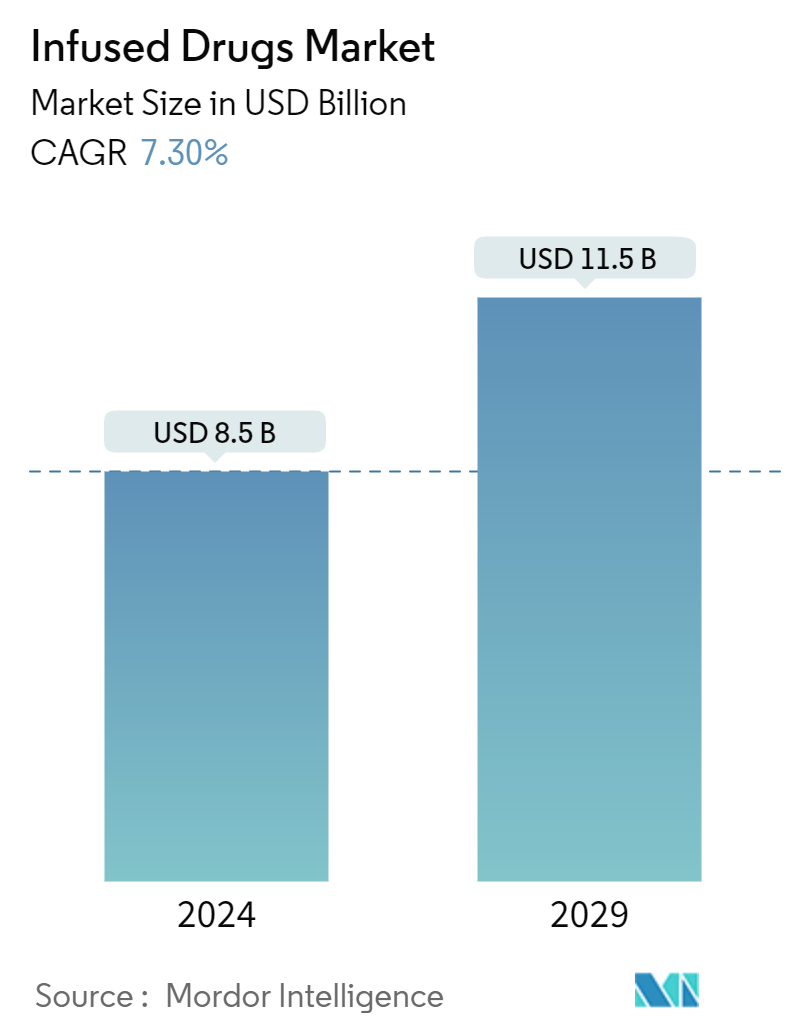
| Study Period | 2019 - 2029 |
| Market Size (2024) | USD 8.5 Billion |
| Market Size (2029) | USD 11.5 Billion |
| CAGR (2024 - 2029) | 7.30 % |
| Fastest Growing Market | Asia Pacific |
| Largest Market | North America |
| Market Concentration | Medium |
Major Players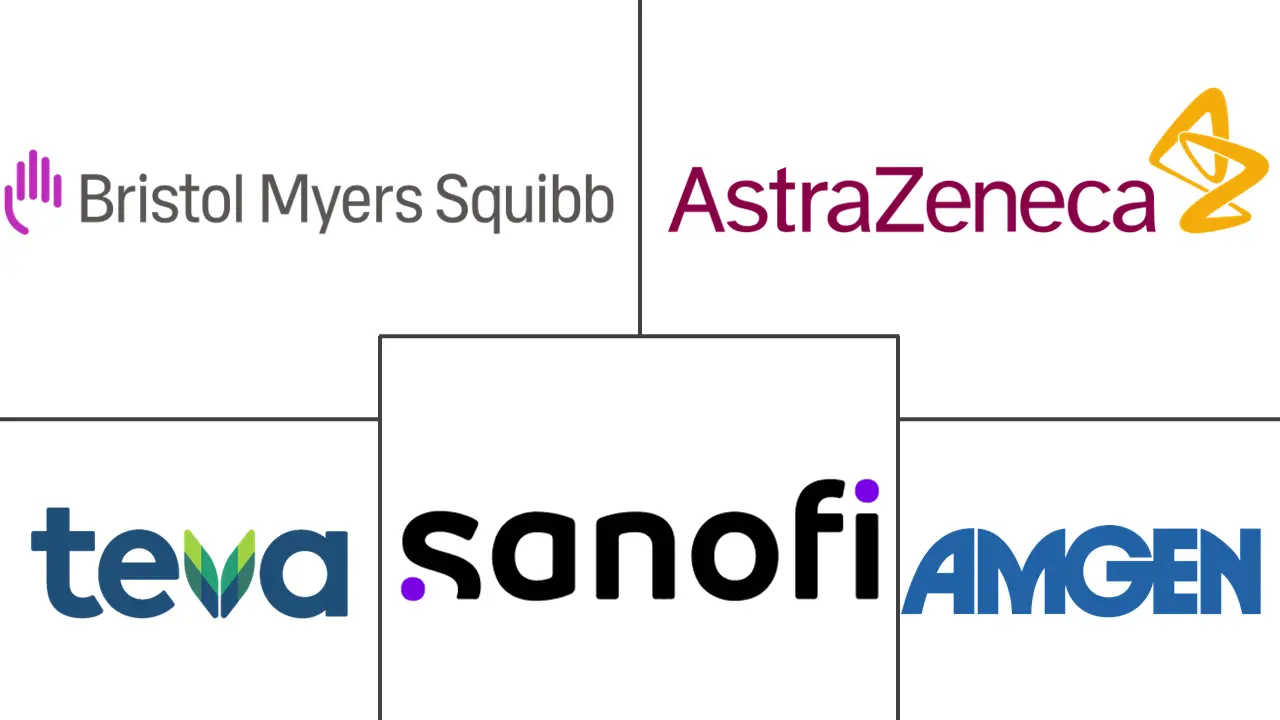
*Disclaimer: Major Players sorted in no particular order |
Infused Drugs Market Analysis
The Infused Drugs Market size is estimated at USD 8.5 billion in 2024, and is expected to reach USD 11.5 billion by 2029, growing at a CAGR of 7.30% during the forecast period (2024-2029).
The key factors driving the growth of the infused drugs market are the growing prevalence of chronic diseases, advancements in drug delivery systems, and the rising geriatric population. For instance, in 2022, there were approximately 670 million people aged 60 years or older in Asia-Pacific, which accounted for roughly one in every seven people in the region. By 2050, the number is projected to be doubled to 1.3 billion. Among the elderly population in Asia, women comprise 54%, and this tends to increase with age due to their long life expectancy, according to a report by the United Nations Economic and Social Commission for Asia and the Pacific. The rising geriatric population is expected to drive the market over the forecast period.
- Moreover, the increasing prevalence of chronic conditions such as cardiovascular diseases, oncology diseases, and diabetes contribute to the market's growth. For instance, according to the report published by the British Heart Foundation (BHF) in April 2023, more than 7.6 million people were living with heart and circulatory diseases in the United Kingdom in 2022, which is further projected to increase with the aging population, decreasing fertility rates, and increasing survivability from other chronic diseases. Hence, the rising prevalence of chronic diseases is expected to increase the demand for infused drugs to effectively manage these diseases, ultimately driving the market studied market.
- Furthermore, increasing strategic activities such as acquisitions and product launches are also expected to drive the market. For instance, in March 2024, Bristol Myers Squibb received approval from the United States Food and Drug Administration for a biological product, Breyanzi, a CD19-directed chimeric antigen receptor (CAR) T cell therapy, for the treatment of adult patients with relapsed or refractory chronic lymphocytic leukemia (CLL). Breyanzi is delivered through a treatment process that culminates in a one-time infusion with a single dose containing CAR-positive viable T cells. Such product launches are expected to drive the market over the forecast period.
- However, the side effects associated with infusion drugs, strict regulations, and the high cost of manufacturing and developing infusion drugs may restrict the growth of the infused drugs market.
Infused Drugs Market Trends
Oncology is Expected to Have Significant Market Share During the Forecast Period
- The rising prevalence of cancer is expected to increase the demand for infused drugs because of their rapid action in cancer patients. For instance, according to the report published by the Spanish Network Of Cancer Registries in January 2023, about 295,675 new cases were reported in Spain in 2023, which represented 1.96% more compared to 2022. The increasing prevalence of cancer is expected to drive the demand for infused drugs.
- Moreover, the funding for research and development of novel medicines in oncology is increasing. For instance, in the United States, the National Institute of Health (NIH) invested USD 8,078 million in 2023 compared to 7,635 million in 2022 for its research activities associated with cancer. Such development activities in oncology are expected to increase the novel infused anti-cancer medicines in the market.
- Furthermore, the increasing strategic activities, such as product launches, are expected to drive the growth of the oncology segment. For instance, in October 2022, the United States Food and Drug Administration approved the Teclistamab-cqvy (Tecvayli), for the treatment of relapsed/refractory multiple myeloma.
- Therefore, the rising prevalence of cancer and increasing product launches are expected to drive the growth of the segment over the forecast period.
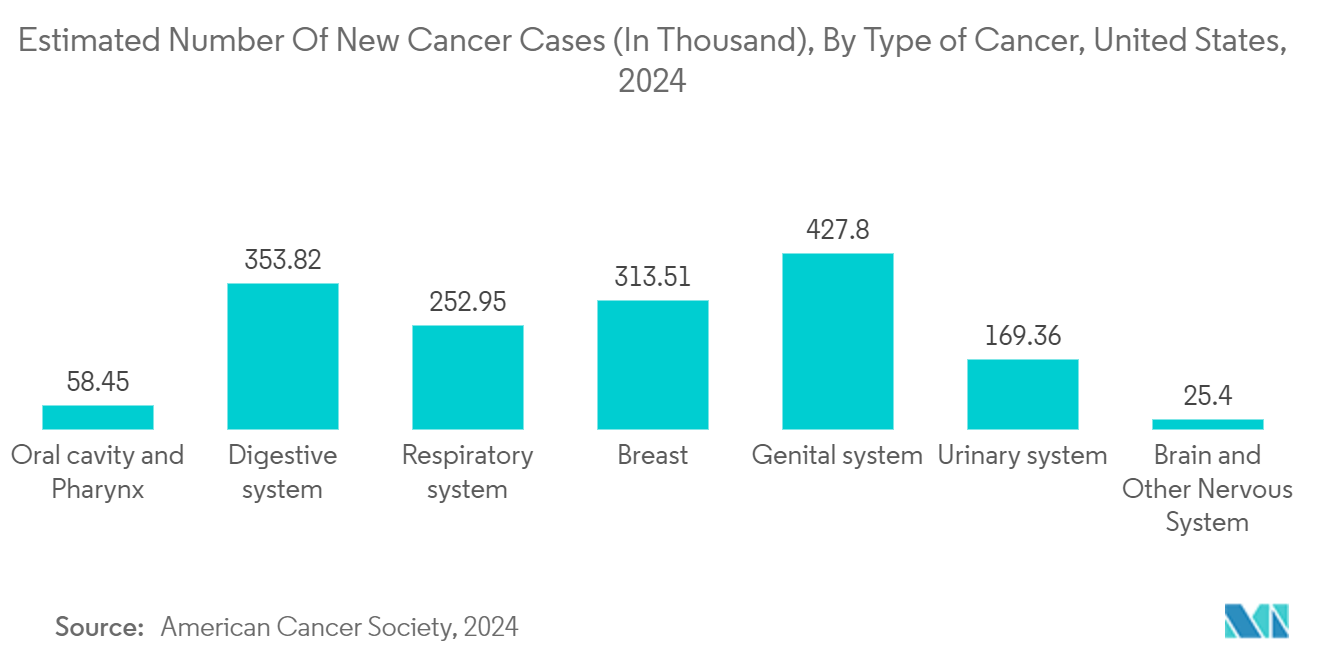
North America Holds Significant Market Share
- The North American infused drugs market is expected to grow over the forecast period owing to factors such as the rising prevalence of chronic diseases, such as cancer and infectious diseases, coupled with the increasing investment in research and development activities. Increasing strategic activities such as product launches and acquisitions by key players are also expected to drive the market in the region.
- The rising prevalence of chronic diseases such as cancer is expected to increase the demand for specialty therapeutics that are used in oncology. For instance, according to the American Cancer Society’s updated data in 2023, the incidence of lung cancer is increasing in the United States, and the country reported 238,340 lung cancer cases in 2023 compared to 236,740 in 2022. Similarly, as per the Canadian Cancer Society's updated data from January 2024, it was estimated that in 2023, around 124,200 males and 114,900 females were diagnosed with cancer. Prostate cancer accounts for one-fifth (20%) of all new cancer cases in males in 2023. Hence, the significant prevalence of cancer cases in North America is projected to spur the demand for infused drugs.
- The increasing investments in research and development by governments and private organizations are also expected to drive the market in North America. For instance, in November 2023, the National Multiple Sclerosis Society invested USD 4.4 million in new research projects, aligning with the strategy to guide global MS research toward promising areas outlined in the Pathways to Cure's roadmap. Furthermore, in March 2023, in the United States, Bayer AG planned to invest USD 1.0 billion in the research and development of drugs. Such huge investments in research and development can lead to novel infusing product launches.
- Hence, the rising prevalence of cancer cases and increasing investments in research and development investments by governments and private organizations are expected to drive the market in North America over the forecast period.
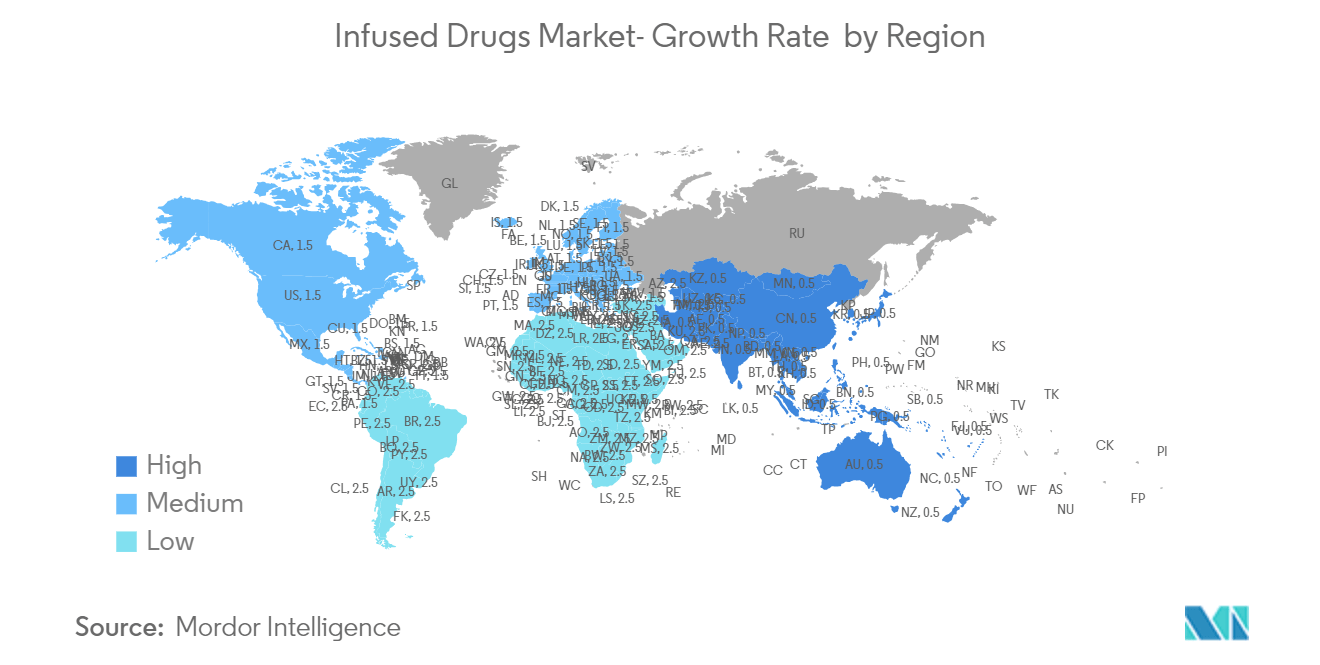
Infused Drugs Industry Overview
The infused drugs market is moderately competitive. The key players are adopting various strategies such as product launches, expansion of the products and services into new regions, mergers, acquisitions, and entering new partnerships and collaborations to strengthen their position in the market. The key players include AstraZeneca, Sanofi SA, Teva Pharmaceutical Industries Ltd, Amgen, Inc., and Bristol-Myers Squibb Company.
Infused Drugs Market Leaders
-
AstraZeneca
-
Sanofi SA
-
Bristol-Myers Squibb Company
-
Amgen, Inc.
-
Teva Pharmaceutical Industries Ltd.
*Disclaimer: Major Players sorted in no particular order
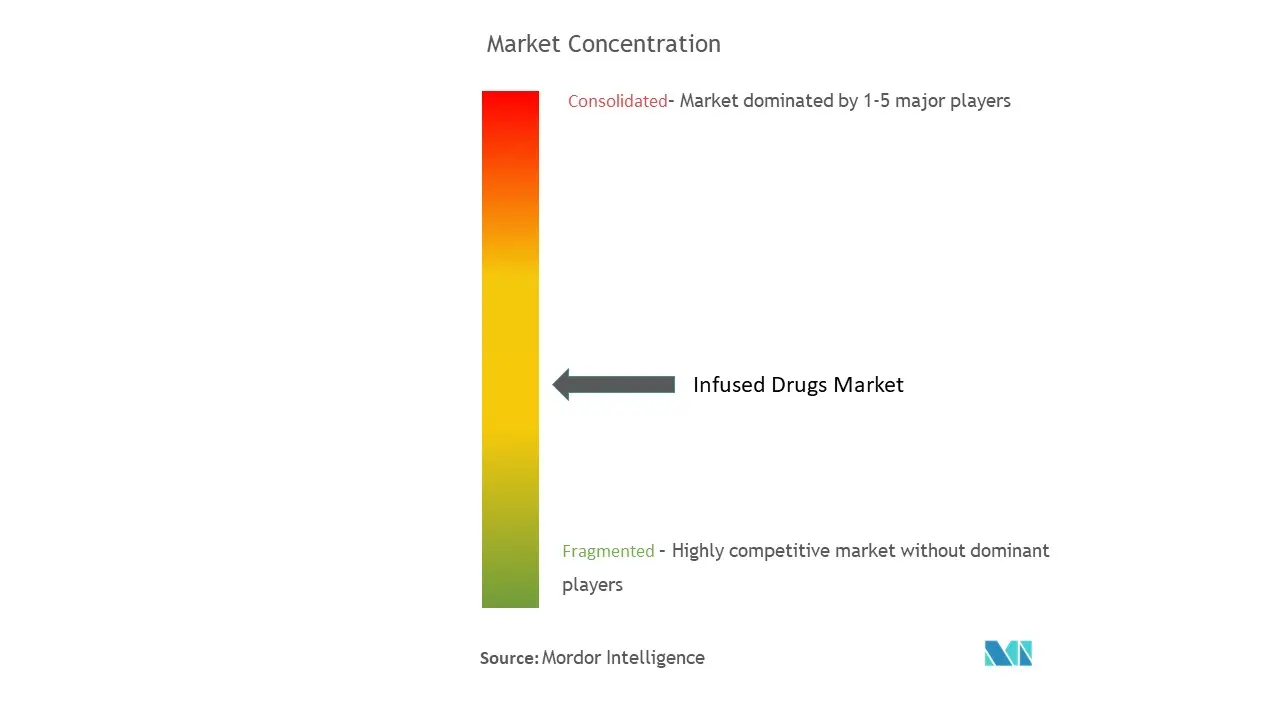
Infused Drugs Market News
- September 2023: Eisai Co. Ltd and Biogen Inc. reported the approval of LEQEMBI intravenous infusion, a humanized anti-soluble aggregated amyloid beta monoclonal antibody in Japan. This approval signifies its recognition as a treatment to decelerate the progression of mild cognitive impairment and dementia resulting from Alzheimer’s Disease.
- August 2023: Halozyme Therapeutics Inc. reported that the Medicines and Healthcare Products Regulatory Agency (MHRA) in Britain approved Roche’s Tecentriq SC using Halozyme’s Enhaze drug delivery technology. The Tecentriq SC, co-formulated with halozyme’s enzyme, enables subcutaneous delivery in about 7 minutes.
Infused Drugs Market Report - Table of Contents
1. INTRODUCTION
1.1 Study Assumptions and Market Definition
1.2 Scope of the Study
2. RESEARCH METHODOLOGY
3. EXECUTIVE SUMMARY
4. MARKET DYNAMICS
4.1 Market Overview
4.2 Market Drivers
4.2.1 Increase in the Prevalence of Chronic Diseases
4.2.2 Increasing Geriatric Population
4.3 Market Restraints
4.3.1 Side Effects Associated with the Medications
4.4 Porter's Five Force Analysis
4.4.1 Threat of New Entrants
4.4.2 Bargaining Power of Buyers/Consumers
4.4.3 Bargaining Power of Suppliers
4.4.4 Threat of Substitute Products
4.4.5 Intensity of Competitive Rivalry
5. MARKET SEGMENTATION (Market Size by Value - USD)
5.1 By Drug Type
5.1.1 Small Molecules
5.1.2 Biologics
5.2 By Therapeutic Area
5.2.1 Oncology
5.2.2 Gastrointestinal Diseases
5.2.3 Rheumatoid Arthritis
5.2.4 Immune Deficiencies
5.2.5 Cardiology
5.2.6 Neurology
5.2.7 Diabetes
5.2.8 Other Therapeutic Areas
5.3 By Geography
5.3.1 North America
5.3.1.1 United States
5.3.1.2 Canada
5.3.1.3 Mexico
5.3.2 Europe
5.3.2.1 Germany
5.3.2.2 United Kingdom
5.3.2.3 France
5.3.2.4 Italy
5.3.2.5 Spain
5.3.2.6 Rest of Europe
5.3.3 Asia-Pacific
5.3.3.1 China
5.3.3.2 Japan
5.3.3.3 India
5.3.3.4 Australia
5.3.3.5 South Korea
5.3.3.6 Rest of Asia-Pacific
5.3.4 Middle East and Africa
5.3.4.1 GCC
5.3.4.2 South Africa
5.3.4.3 Rest of Middle East and Africa
5.3.5 South America
5.3.5.1 Brazil
5.3.5.2 Argentina
5.3.5.3 Rest of South America
6. COMPETITIVE LANDSCAPE
6.1 Company Profiles
6.1.1 AstraZeneca
6.1.2 Sanofi SA
6.1.3 Pfizer Inc.
6.1.4 Weefsel Pharma
6.1.5 Parenteral Drugs (India) Limited
6.1.6 Bristol-Myers Squibb Company
6.1.7 Regeneron Pharmaceuticals Inc.
6.1.8 Eisai Co. Ltd
6.1.9 Amgen Inc.
6.1.10 Teva Pharmaceutical Industries Ltd
- *List Not Exhaustive
7. MARKET OPPORTUNITIES AND FUTURE TRENDS
Infused Drugs Industry Segmentation
As per the scope of the report, IV infusion puts medicine, blood, or fluid directly into the bloodstream. This makes the treatment fast and powerful. The infused drugs market is segmented by drug, therapeutic area, and geography. By drug, the market is segmented into small molecules and biologics. In terms of therapeutic areas, the market is segmented into oncology, gastrointestinal diseases, rheumatoid arthritis, immune deficiencies, cardiology, neurology, diabetes, and other therapeutic areas. By geography, the market is segmented into North America, Europe, Asia-Pacific, Middle East and Africa, and South America. The market report also covers the estimated market sizes and trends for 17 countries across major regions globally. The report offers values in USD for the above segments.
| By Drug Type | |
| Small Molecules | |
| Biologics |
| By Therapeutic Area | |
| Oncology | |
| Gastrointestinal Diseases | |
| Rheumatoid Arthritis | |
| Immune Deficiencies | |
| Cardiology | |
| Neurology | |
| Diabetes | |
| Other Therapeutic Areas |
| By Geography | ||||||||
| ||||||||
| ||||||||
| ||||||||
| ||||||||
|
Infused Drugs Market Research FAQs
How big is the Infused Drugs Market?
The Infused Drugs Market size is expected to reach USD 8.5 billion in 2024 and grow at a CAGR of 7.30% to reach USD 11.5 billion by 2029.
What is the current Infused Drugs Market size?
In 2024, the Infused Drugs Market size is expected to reach USD 8.5 billion.
Who are the key players in Infused Drugs Market?
AstraZeneca, Sanofi SA, Bristol-Myers Squibb Company, Amgen, Inc. and Teva Pharmaceutical Industries Ltd. are the major companies operating in the Infused Drugs Market.
Which is the fastest growing region in Infused Drugs Market?
Asia Pacific is estimated to grow at the highest CAGR over the forecast period (2024-2029).
Which region has the biggest share in Infused Drugs Market?
In 2024, the North America accounts for the largest market share in Infused Drugs Market.
What years does this Infused Drugs Market cover, and what was the market size in 2023?
In 2023, the Infused Drugs Market size was estimated at USD 7.88 billion. The report covers the Infused Drugs Market historical market size for years: 2019, 2020, 2021, 2022 and 2023. The report also forecasts the Infused Drugs Market size for years: 2024, 2025, 2026, 2027, 2028 and 2029.
Infused Drugs Industry Report
Statistics for the 2024 Infused Drugs market share, size and revenue growth rate, created by Mordor Intelligence™ Industry Reports. Infused Drugs analysis includes a market forecast outlook for 2024 to 2029 and historical overview. Get a sample of this industry analysis as a free report PDF download.



